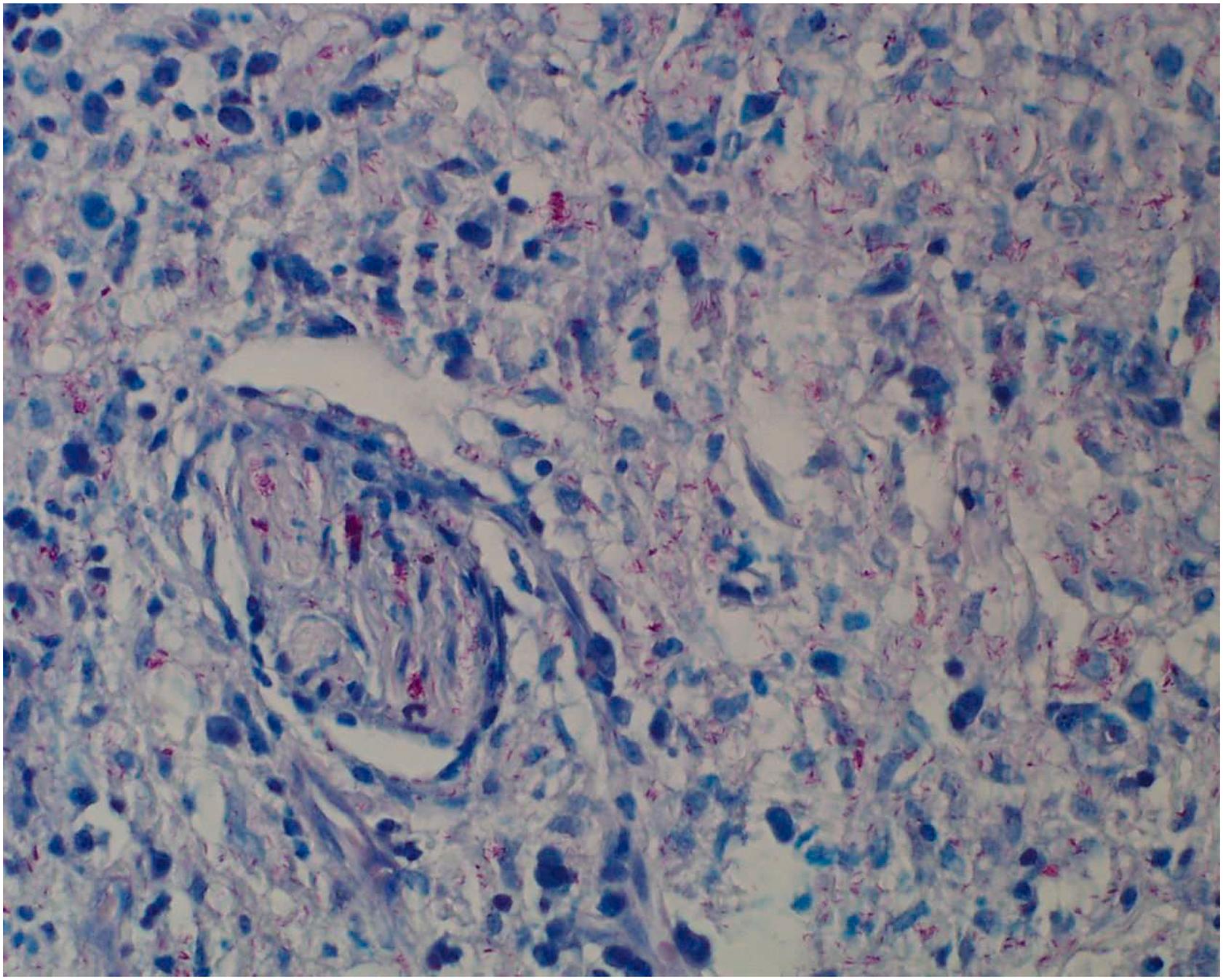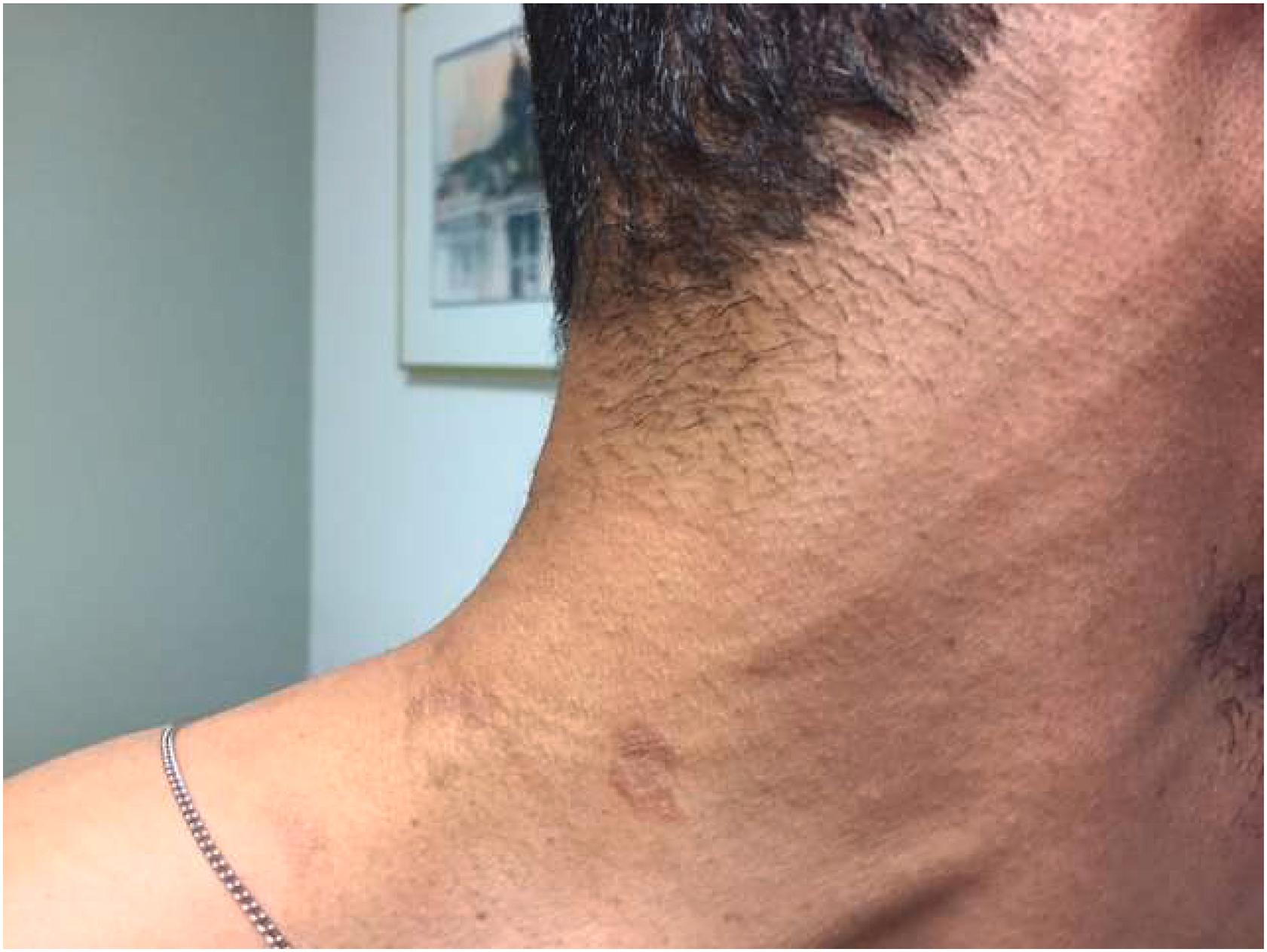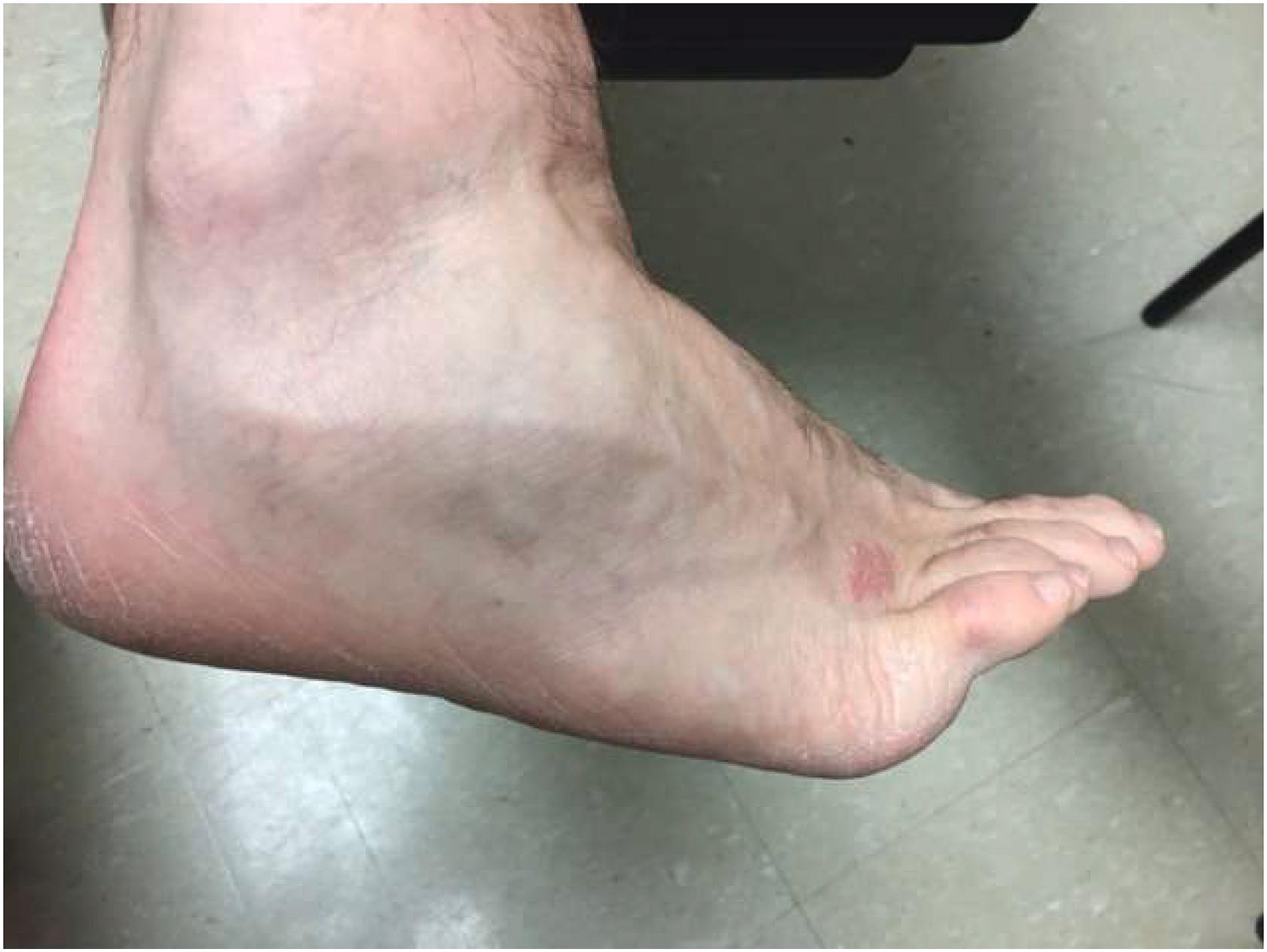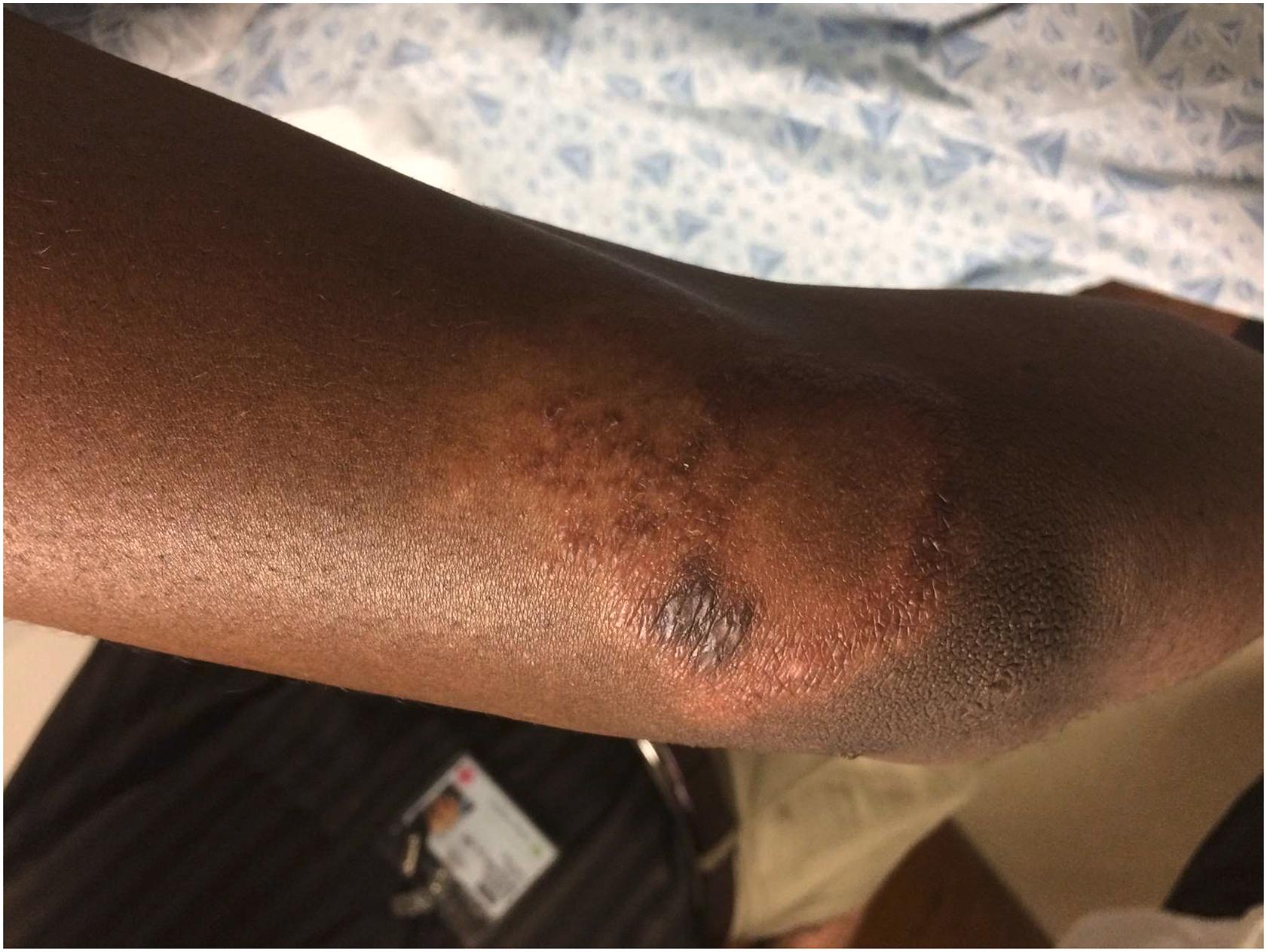Physical Address
304 North Cardinal St.
Dorchester Center, MA 02124
Leprosy is one of the oldest diseases known to afflict humans, with descriptions of the disease present in sixth century BCE Indian texts. It is caused by Mycobacterium leprae ( M. leprae ), the organism first identified by the Norwegian physician, Gerhard Hansen, in 1873. It is an obligate intracellular acid-fast bacillus, which is detected in tissues by the modified Fite-Faraco stain ( Fig. 41-1 ). In 2008 a new species, M. lepromatosis , was identified in Mexico and is now known to cause a syndrome that is clinically equivalent in all respects to classic leprosy. Neither species grows in culture, and with the exception of armadillos, certain primates such as the chimpanzee and macaque, and red squirrels, humans are the primary reservoir and source of infection. The genome of the organism was sequenced in 2001 and has undergone reductive evolution, with only 49.5 percent of its genes being involved in coding. The route of transmission is primarily through nasal droplets. Skin-to-skin contact is not thought to be an important route of infection. Other modes of transmission have been documented and are rare; they include contact with infected soil and direct dermal implantation such as occurs during tattooing. In susceptible individuals, the organisms rapidly gain access to cooler dermal tissues, primarily to cutaneous and subcutaneous nerves, and neural networks, skin appendages, sweat glands, and erector pili muscles. Scollard and colleagues demonstrated that endoneurial vessels in the armadillo serve as the route of entry into the nerve, by demonstrating extensive infection of endothelial cells of endoneurial, epineurial, and perineurial blood vessels.

Leprosy is the leading cause of infectious neuropathy in the developing world. The considerable social stigma that has been associated with this diagnosis through the ages has persisted and can prevent early detection and effective treatment. Not only does M. leprae have a predilection for Schwann cells, but the immunologically mediated reactions seen during antimicrobial therapy cause significant damage to the peripheral nervous system and contribute substantially to disability.
The prevalence of leprosy, defined by the World Health Organization (WHO) as those who are on active mycobacterial treatment, has declined by 96 percent over the last 20 years. This is largely due to the worldwide implementation since 1982 of progressively shorter courses of multidrug therapy (MDT). By 1982, the incidence of leprosy had already declined significantly in countries such as China and Mexico, coinciding with improvement in nutrition and living conditions, and with widespread bacille Calmette-Guérin (BCG) vaccination, which is variably protective against leprosy.
Since the year 2000, however, some 200,000 new cases of leprosy have been detected every year. Although these new cases include individuals who acquired their infection years earlier, there is evidence that transmission of leprosy is continuing unabated, with delays in diagnosis and treatment. At least 9 percent of new cases over the past decade have been in children, and high rates of disability have been seen in new cases in several countries. The latest WHO target for 2020 includes decreasing the number of new patients diagnosed with deformities to less than one per million, and the number of children with disabilities to zero. The decreased incidence numbers do not take into account patients who have significant residual disabilities that require ongoing treatment or rehabilitation after completion of MDT. Furthermore, clinicians taking care of patients with leprosy will continue to treat relapses and reactions for years after completion of MDT.
The clinical spectrum of leprosy correlates with the cell-mediated immunity of the patient. This is the basis for the Ridley-Jopling classification, which includes indeterminate leprosy (I), tuberculoid (TT), borderline tuberculoid (BT), borderline (BB), borderline lepromatous (BL), and lepromatous leprosy (LL) forms ( Table 41-1 ). Patients with tuberculoid leprosy have an excellent cell-mediated immune (Th1) response to M. leprae . This manifests as few skin lesions, which histologically have well-organized granulomas (in which bacteria are rarely found) with CD4-predominant T cells. Patients who have less effective cell-mediated immunity have more aggressive clinical and bacteriologic expression of the disease, known as borderline disease. Finally, patients with LL are anergic to M. leprae , with predominant T-helper 2 (Th2) response, resulting in uncontrolled growth of bacilli and disseminated skin lesions. The reduced cell-mediated immunity to M. leprae in LL is specific for this organism and does not represent a generalized immune deficiency against other pathogens. Interferon-gamma (IFN- γ ) production by T cells is another key component of the protective response against mycobacteria, as this cytokine stimulates infected macrophages to kill intracellular M. leprae. In TT leprosy there is increased expression of type-1 cytokines IFN- γ and tissue necrosis factor-alpha (TNF-α), whereas in LL disease there is a predominance of the type-2 cytokines such as interleukin-10 (IL-10). Histologic examination of LL lesions reveals sheets of foamy macrophages in the dermis, containing large numbers of bacilli in microcolonies packed in parallel, like cigarettes in a packet, called “globi” with small numbers of CD8 + T cells. In the WHO’s simplified clinical classification scheme, TT and BT types are identified as “paucibacillary” (PB, 2 to 5 skin lesions) and types BB–LL as “multibacillary” (MB) ( Table 41-1 ).
 |
Genetic susceptibility to leprosy has been postulated as an important factor in the acquisition and manifestation of leprosy. HLA genes may also influence the type of leprosy that develops; for example, tuberculoid leprosy develops more frequently in individuals with HLA-DR3, whereas LL is more prone to develop in those with HLA-DQ1 or HLA-MT1. Toll-like receptor (TLR) activation plays an important role in innate immunity to pathogens by the upregulation of antigen-presenting molecules and secretion of cytokines. Toll-like receptor 1 and 2 (TLR1 and TLR2) expression in monocytes has been found to correlate with the clinical presentation of leprosy, especially TLR2 microsatellite polymorphisms and TLR2 SNP. Patients with tuberculoid leprosy strongly express these receptors, whereas patients with LL express them weakly.
M. leprae ’s affinity to Schwann cells is mediated by Fc receptors, complement receptors, the fibronectin binding protein, and TLR2. Phenolic glycolipid 1 (PGL-1), which is an M. leprae -specific antigen, has been shown to bind to laminin of Schwann cells. PGL-1 also binds to complement (C3), and this complement –M. leprae complex in turn binds to macrophages and monocytes via complement receptors (CR1, CR3, and CR5), resulting in a three-component receptor–ligand–acceptor molecule for mediating phagocytosis of the organism by human monocytes. M. leprae attaches to Schwann cells via PGL-1, binding specifically to the G domain of the α-2 chain of laminin-2 (a protein constituent of the extracellular basal lamina) that, in turn, binds to α-dystroglycan on the plasma membrane of the Schwann cells.
In a classic series of experiments, Rambukkana and colleagues showed that M. leprae preferentially invades nonmyelin-producing Schwann cells where the organisms multiply in large numbers, serving as a reservoir for organism growth. After attachment of the organism, myelin-producing Schwann cells undergo significant loss of myelination by an immune-independent mechanism. Dystroglycan complexes link the basal lamina to the cytoskeleton of Schwann cells through membrane-associated linker proteins called dystrophins or utrophins, which are believed to transduce signals from the exterior to the interior of the cells. Myelin-producing Schwann cells contain a third complex, dystrophin-related protein 2 (DRP2), the disruption of which results in demyelination of nerves. It is hypothesized that the loss of myelin production by infected Schwann cells in leprosy may be due to the interaction of PGL-1 with the DRP2–dystroglycan complex. This is followed by dedifferentiation of the Schwann cells to the nonmyelin-producing phenotype that is very vulnerable to invasion by the bacteria.
The survival of M. leprae within Schwann cells is greater at 33°C and therefore it has an affinity for nerves at superficial, cooler sites. The Schwann cells are also altered by infection, producing metabolic and functional changes that trigger the immune system in recruiting cytotoxic cells, T lymphocytes, and macrophages. The end result is unrestrained multiplication of the organism within Schwann cells, destruction of myelin, inflammatory changes, and secondary destruction of the nerve architecture. The discovery that demyelination can be induced in vivo by the bacterial cell-wall antigen alone may explain the ongoing neurologic damage that can occur in leprosy after treatment.
Nerve growth factor (NGF) is a neurotrophin produced by multiple cell types, including neurons, Schwann cells, lymphocytes, and mast cells. The role of NGF in leprosy is not fully understood but it is likely that it is involved in the nerve damage and ensuing neuropathic pain. Studies have shown that higher levels of NGF are associated with LL and low levels are associated with tuberculoid forms of the disease. NGF may also play a role in neuropathic pain, and this may be an important pathway in developing future remedies for pain.
The genome of M. leprae is the smallest among mycobacteria, with approximately 1,605 genes encoding proteins and 1,300 pseudogenes. Compared to the bacterium causing tuberculosis, M. leprae reveals extreme reductive evolution with less than half of the genome containing functional genes. Reductive evolution, gene decay, and genome downsizing may explain the unusually long generation time and the inability to culture the organism in vitro. The genome is also highly conserved, with <300 single-nucleotide polymorphisms (SNPs) observed between distantly related strains, and only a few SNPs between closely related strains. Only 16 SNP subtypes have been defined. Genotyping M. leprae strains from around the world has enabled detailed phylogenetic and phylogeographic comparisons to be made, new mutations associated with antimicrobial resistance to be detected, and the likely origin of leprosy to be proposed. It has allowed the identification of the new species, M. lepromatosis , and the study of the presence of zoonotic leprosy in armadillos in the southern United States.
The incubation period ranges from 3 months to 40 years, with an average of 7 years. The onset of the disease is insidious, with the skin and peripheral nervous system primarily being involved. Three cardinal signs remain the mainstay for the diagnosis of leprosy in clinical practice: anesthetic skin lesions, enlarged peripheral nerves, and acid-fast bacilli demonstrated by Fite-Faraco staining in skin smears or skin biopsies ( Fig. 41-1 ). The bacilli favor the cooler areas of the body, such as the chin, malar areas of the face, earlobes, buttocks, knees, and distal extremities. Skin lesions range from the asymptomatic, ill-defined, slightly hypopigmented, macule of indeterminate leprosy to the diffuse infiltration seen in LL that causes thickening of the skin of the face and earlobes (leonine facies). Approximately 5 percent of patients present with nerve involvement without skin lesions; this is called primary neuritic leprosy (PNL), the diagnosis of which may require nerve biopsy and polymerase chain reaction (PCR) assistance. The clinical and histopathologic features of the main types of leprosy are shown in Table 41-2 .
| Tuberculoid Leprosy (TT) | Borderline Leprosy | Lepromatous Leprosy (LL) | |
|---|---|---|---|
| Dermatologic features | Single or few anesthetic macules or plaques with well-defined borders. | Many anesthetic lesions with ill-defined to indistinct borders. Satellite lesions around larger lesions. | Multiple, nonanesthetic symmetrically distributed macules or papules progressing to diffuse infiltration of skin. |
| Clinical features of neuropathy | Asymmetric nerve enlargement usually found proximal to skin lesion. | Multiple nerves may be involved. Involvement is earlier and more rapid than in LL. | No neural lesions until late, when bilateral symmetric distal neuropathies occur. |
| Histopathology |
|
Findings range from those seen in TT to those in LL with variable presence of bacilli. | Greater preservation of nerve structure with sheets of foamy cells in the perineum resembling onion skins. Numerous bacilli are seen. |
The initial manifestations of leprosy are due to direct infection of dermal nerves resulting in anesthetic patches. The nerve damage extends from this early lesion with involvement of a small superficial nerve twig and skin anesthesia to infection of many nerves and involvement of larger skin areas. Patients may subsequently develop more widespread neuropathies with greater sensory and motor deficits, sometimes preceded by pruritus, paresthesias, and rarely pain. In untreated cases, this type of leprosy becomes widespread and symmetric within superficial skin tissues and peripheral nerves. Because the immune response to the bacilli in LL is very indolent, neuropathy usually evolves over many years. As in tuberculoid disease, neuropathies involving larger, superficially located nerve trunks in the face, arms, and legs may also occur.
Initially, there is loss of thermal sense followed by sequential loss of nociceptive and pressure sensations. The affinity of M. leprae for Schwann cells and their predilection for cooler parts of the body have made certain segments of nerve trunks vulnerable. The nerves most likely to be involved are the ulnar nerve at the elbow, the median nerve immediately proximal to the carpal tunnel, the radial nerve at the spiral groove, the peroneal nerve at the fibular head, the tibial nerve proximal to the ankle, and the facial nerve at the region of the zygomatic bone. Sensory nerves such as the superficial peroneal, posterior auricular, sural ( Figs. 41-2 and 41-3 ), and superficial radial nerves and the dorsal branch of ulnar nerve may also be involved. Unperceived trauma secondary to sensory loss further aggravates the nerve damage.


Mycobacteria also invade the anterior chamber of the eye, upper respiratory tract, lymph nodes, periosteum, and testes. Eyebrows and eyelashes may be lost (madarosis), and anesthesia of affected areas is extensive and accompanied by anhidrosis. Sensory loss is largely due to destruction of intracutaneous nerve endings and first appears in cool areas, but with initial sparing of the soles of the feet and palms of the hands. There is also involvement of superficial facial nerve twigs, causing lagophthalmos and paralysis of some segments of the orbicularis oris and frontalis muscles. The sensory loss spares warmer areas including the intergluteal fold, the perineum, and the areas of the scalp covered by hair. Despite the appearance of an extensive sensorimotor neuropathy with clawed toes, foot drop, and clawed hands, preserved muscle stretch reflexes are the rule. Nerves that are grossly enlarged and infiltrated with abundant bacilli may still function well but are more susceptible to recurrent trauma.
Nerve damage in tuberculoid leprosy is usually asymmetric and is often confined to the nerves underlying or near a skin lesion. Dermal nerves are infiltrated by granulomas composed of epithelioid cells and lymphocytes, with destruction of Schwann cells and secondary axonal damage. Nerves may be palpably enlarged and painful; calcification of nerves sometimes occurs in long-standing disease. The picture is generally one of a clearly visible skin lesion that is usually hypopigmented, with an elevated border ( Fig. 41-3 ) and with a corresponding demarcated patch of sensory loss and absent sweating. Local bacillary invasion of nerves (although acid-fast bacilli are rarely seen on biopsy) and a robust immune response are the two factors that result in focal, limited, and asymmetric disease. Motor, sensory, or mixed nerves near a solitary tuberculoid patch may be affected. Subcutaneous sensory nerves near the tuberculoid patch are often enlarged. The tissue response within nerves may be so intense that there is necrosis and formation of a “cold” abscess. Enlarged nerves may be palpated or demonstrated on ultrasound.
Neuropathy in borderline leprosy can produce the most deformity as multiple nerves may be involved. Nerve damage occurs more rapidly than in LL and irreversible nerve destruction may occur. Borderline leprosy is immunologically unstable and movement along the spectrum may occur: either an upgrading response to the tuberculoid or a downgrading to lepromatous forms. When the clinical illness is toward the tuberculoid spectrum (BT), there may be a single lesion with asymmetric nerve involvement, but as the disease moves towards the lepromatous pole (BL) multiple symmetric skin and nerve lesions may be seen ( Fig. 41-4 ).

Become a Clinical Tree membership for Full access and enjoy Unlimited articles
If you are a member. Log in here